Creating content without a strategy is like setting sail without a compass: You’re bound to forget the most important elements of conversion-focused content.
Doing SEO and content marketing for more than a decade, I made sure to nail search intent, content structure, and search engine ranking factors in my content marketing strategy. I refined this content marketing strategies list along the way as search engine algorithms evolved.
Fast forward to today, I’ve proven that these strategies work. Dive into this 11-point content marketing strategy checklist, complete with a handy template. Let’s make sure your content delivers traffic and conversions at the same time.
11-Point Content Marketing Strategy Checklist: Breaking It Down Into Actionable Steps
With this proven content strategy checklist, you can create content that resonates with your target audience. You’ll discover the “must-haves” to captivate their attention and encourage loyalty. As you go through each step, take note of the golden nuggets and actionable insights you’ll need to master.
Before Content Creation
1. Why am I creating content?
The answer to this question pushes you to the heart of your content creation efforts. Content marketing is not simply churning out articles or videos; it’s a call to introspection.
Why are you investing time and resources into creating content?
- To attract new leads?
- Is it to increase organic traffic?
- To nurture your existing customers?
- To become a thought leader in your niche?
- Or turn your qualified leads into paying customers?
When you know the “why” behind your content, you and your content marketer can make sure that each piece you produce aligns with your overall marketing strategy.
For instance, if you’re focused on SEO optimization, your content should be tailored to rank higher on search engines. That could mean putting more effort and resources into factors like:
- Page speed
- Link-building
- Guest posting
- Meta tags optimization
- Search term deconstruction
On the contrary, if attracting qualified leads is your main goal, then targeted, valuable content that addresses specific pain points and offers solutions becomes paramount.
How do you do this? Be SMART.
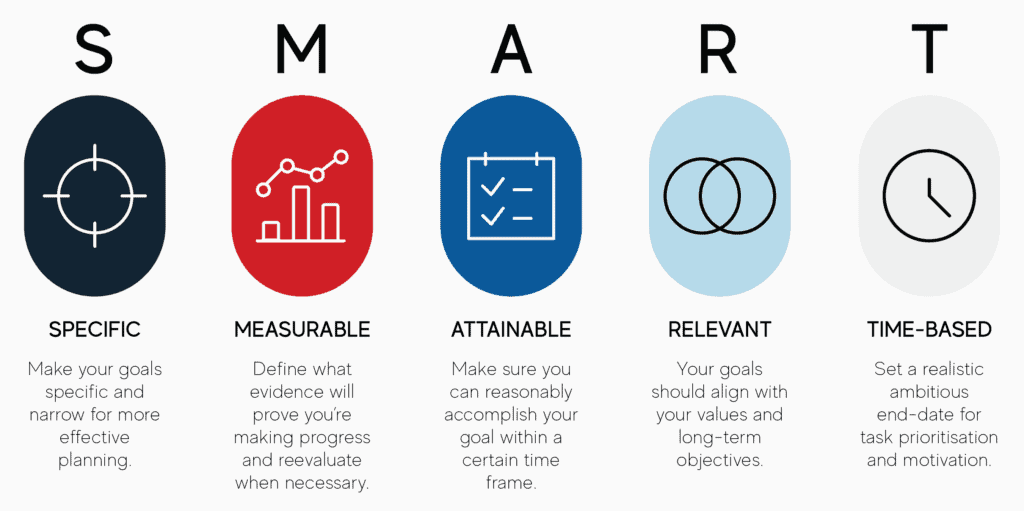
Instead of saying, “I want more website traffic”, a SMART goal would be, “ I want to increase website traffic by 20% in the next 6 months through SEO-optimized B2B blog posts.”
This not only gives you a clear target but also a timeframe and a method.
Setting specific goals lets you measure your progress, adjust your digital marketing tactics as necessary, and make sure your content marketing efforts yield tangible results.
2. Do I understand my audience well?
Understanding your audience means diving into your target demographic’s psyche.
You don’t want them going, “ Is this article for me?” or “Not what I need”, right?
When you grasp who your audience is and what they need you can craft relevant content that strikes a chord, resonating deeply with them. But this isn’t just about knowing their age and location. It means identifying their pressing concerns, pain points, and aspirations.
How do you target the right audience? Create personas.
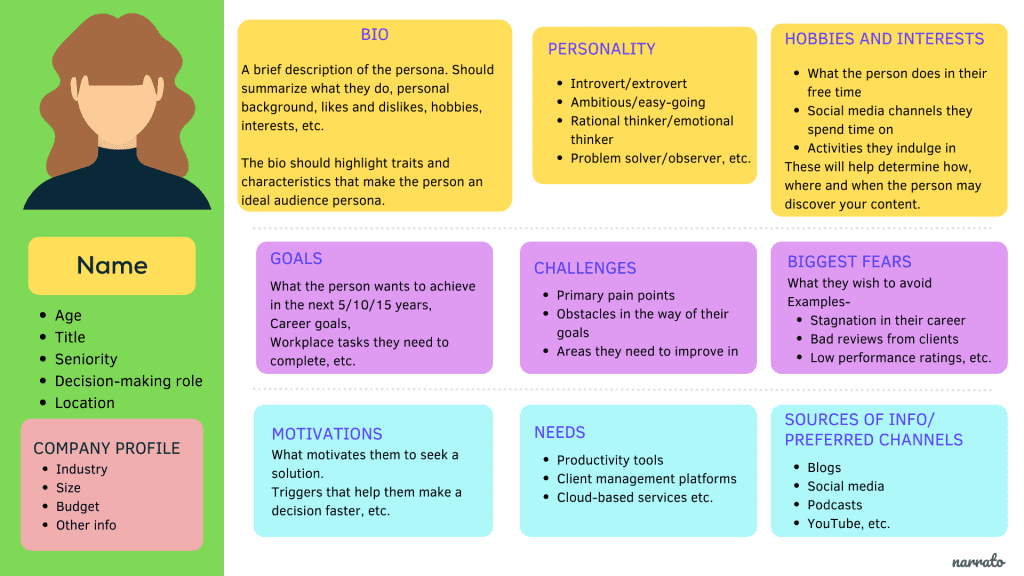
These fictional, detailed representations of your ideal customers guide your content creation process, making sure you address the very issues your audience grapples with.
But how do you get the information you need for your buyer personas?
Here’s where content marketing tools and market research come into play:
| Tools | Functions |
| Survey Monkey | You can create surveys and forms to directly ask your audience about their preferences and challenges. It offers preset questions and themes, and if you prefer, you can also create your own. |
| AnswerThePublic | This tool visualizes search questions and prompts around a specific search term. It gives you relevant terms from A to Z. All you need to do is type the search term and you’ll get instant results. |
| Google Analytics | Beyond just website traffic, this delves into your site visitor’s demographics, interests, and behavior. This data helps refine your content to better suit your audience’s tastes. |
| Usepanda.com | It lets you stay updated with trending topics in your industry by aggregating content from various sources. You can use this to plan your next content ideas. |
3. What topics should I write about?
Here’s where you deep dive into search intent. When you publish content, it should be more than just words on a page; it should be high-quality content that speaks directly to your readers’ interests.
Knowing the right topics is one of the essential elements to elevate your content marketing efforts. You can use the tools mentioned in the table from the previous section to help you.
However, using them to find your target audience’s interests isn’t the end of the story. You’ll still have to delve deeper into their specific queries and concerns, so you can directly address them through your content.
How do you know which topics your target audience will love?
It starts with the search term deconstruction, aka search term research. To find relevant target search terms, use the following tools:
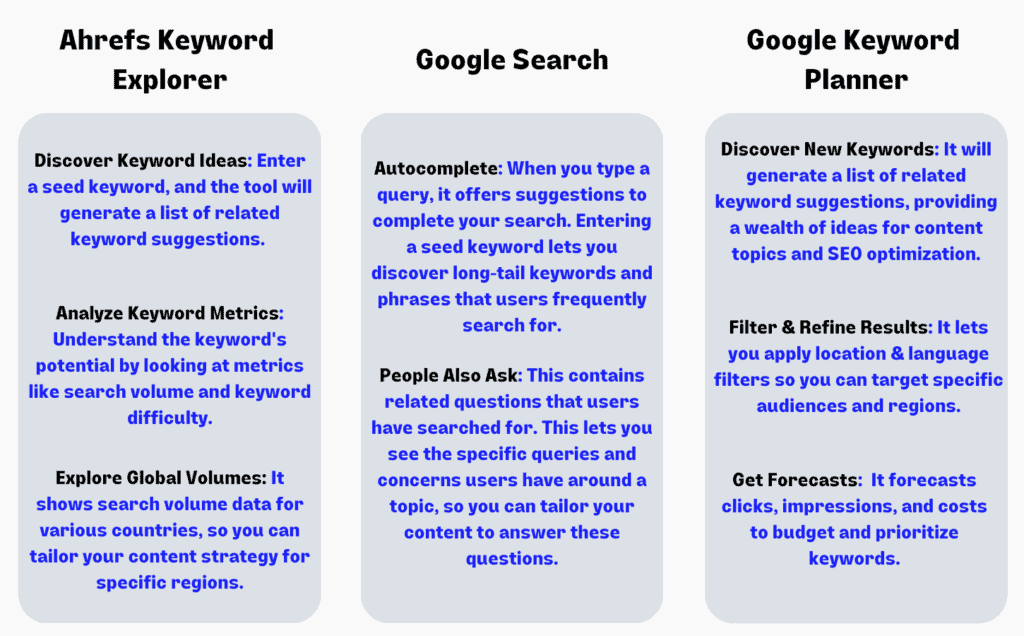
With this step, you’ll pinpoint primary topics (hubs) and their associated subtopics (sub-hubs) that have significant search volume (1,000-10,000) that cater to your audience and relate to your offers.
Take “digital marketing” as a prime example: it’s a major hub encompassing sub-hubs like SEO, PPC, and email marketing. These sub-hubs further branch out into a myriad of specific topics.
From there, establish a clear topic hierarchy. Organize topics into tiers based on their relevance and authority. This structured approach guarantees that each subject has comprehensive coverage, fortifying your topical authority in the process.
But what are those tiers?
- Tier 1: These are the hubs or the main topics (e.g. Content Marketing).
- Tier 2: These are the subtopics or entities related to the main hub (e.g. The 10 Benefits Content Marketing Offers or Content Marketing Best Practices).
- Tier 3: These are mostly low volume/long tail search terms that cover the topics more holistically (e.g. Benefits of Content Marketing SEO For Small Businesses or Content Marketing Best Practices For Start-ups).
After that, identify in which funnel each search term falls under.
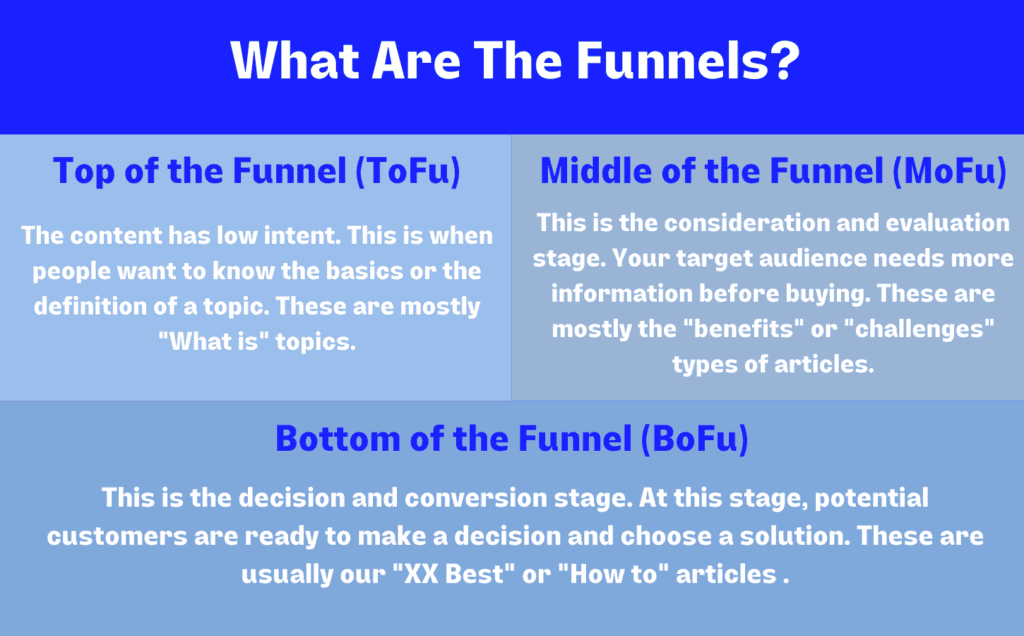
But that’s not all. To evaluate potential content ideas and make sure your content has a purpose, ask yourself:
- How can this help my audience?
- Does this content propose a solution for their pain points?
- What will this do to my brand (e.g. increase leads, drive traffic)?
Consider spying on competitors to find answers. With Ahrefs’ Content Gap feature, you’ll discover search terms they rank for but you have yet to publish content on.
As for your content titles: Leverage SERP to determine the search intent. Then, create a benefit-driven title that aligns with it.
Here are the search intent types to guide you:
- Commercial Intent
- Navigational Intent
- Informational Intent
- Transactional Intent
For example, if the search intent is informational, like “how to grow indoor plants,” a benefit-driven title could be “Grow Thriving Indoor Plants In 3 Easy Steps.”
You should also leverage content audits to make sure you’re not just creating duplicate content. If it’s a duplicate, you can either improve the existing one or delete it and make a completely new post.
4. Do I have a strategic content calendar?
A strategic editorial calendar involves planning and organizing your content production process. But don’t mistake it as simply scheduling. This is the backbone of a successful content marketing strategy.
Why?
Because it keeps you consistent, helps you track topics, and aligns your content with key business events or trends. With it, you’re bound to deliver timely, relevant content that resonates with your audience.
How do you create an effective content calendar?
Include all the key details like the primary search term, content type, and funnel stage. This aids writers in pinpointing search intent. Then, for a smoother workflow, include status, due dates, and assigned writers. This helps with transparency and accountability.
Additionally, don’t forget a tab for the meta descriptions. It’s better to have one ready for when you publish the piece through your content management system, keeping everything organized and efficient.
Use Google Calendar to send alerts to writers and other stakeholders about deadlines and other updates.

To further make your content marketing process seamless, include a checklist in another tab of the same spreadsheet. Your writer can refer to this content marketing checklist while doing the piece to make sure essential elements like incorporating internal and external links, including a pitch, and adding the target search terms in headings are done.
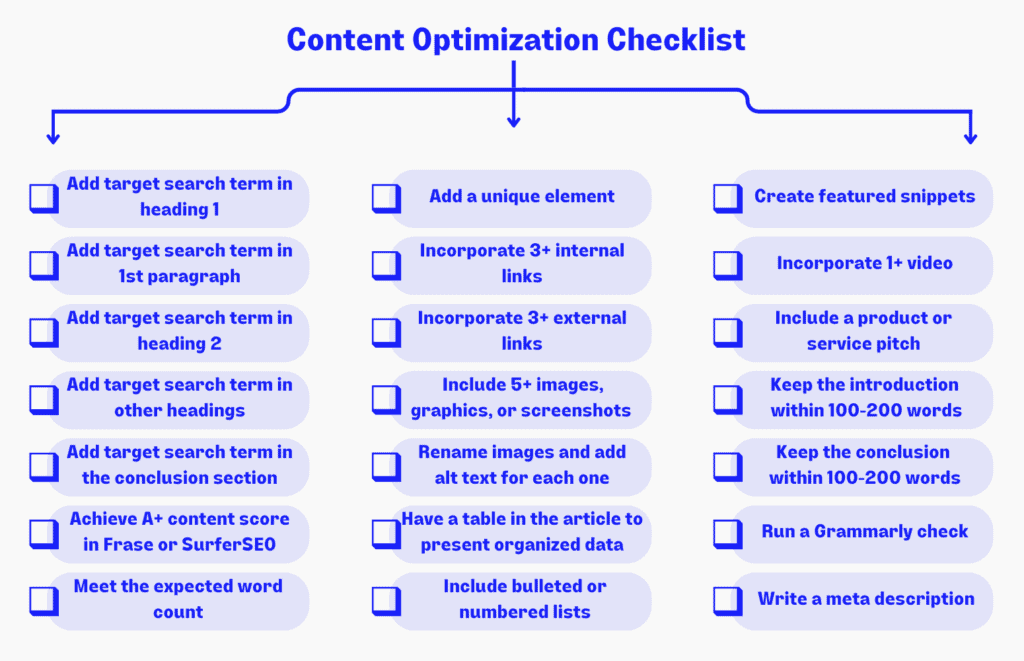
5. Do I have a content guideline?
The content guideline acts as a road map for your content creation. It helps you, your content marketers, and writers to make sure every content piece, from blog posts to video content, aligns with your brand’s voice and business objectives.
Why is this important? For consistency.
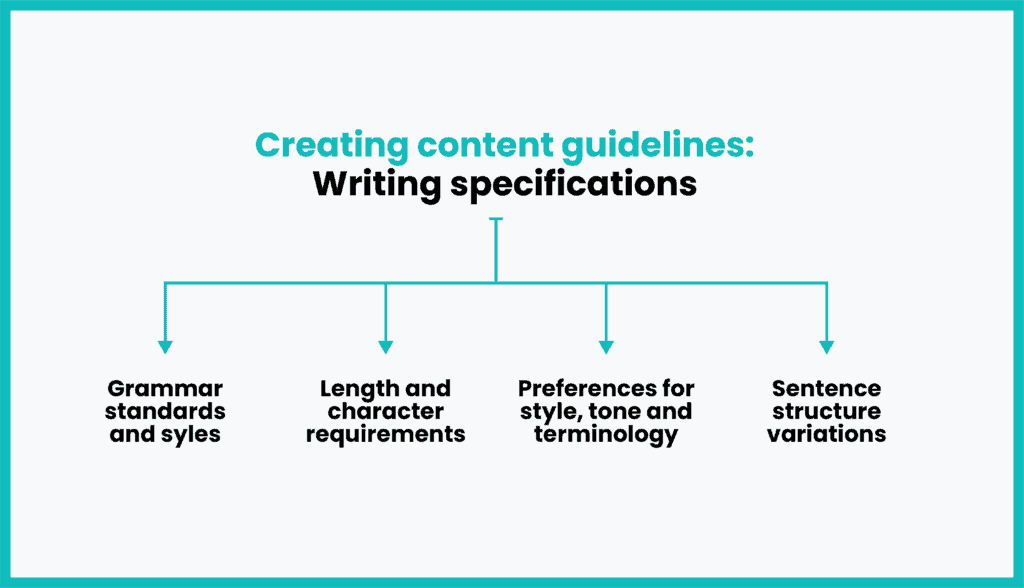
A content guide will make it easy to keep content style and quality so your message comes across clearly. It’ll also aid your writers in producing top-tier, valuable content. Plus, it helps keep everyone on the same page on brand preferences, voice, and style.
As an example, your content guideline can include the following elements:
- General Structure: Make the blog post scannable and easily digestible. Incorporate headings, subheadings, bullet points, and tables.
- Voice: Use an active voice and decide how you want to convey your content. Do you want to be formal or informal? Make sure it’s engaging and conversational.
- Introduction: Treat this as the most important part of the article to entice readers to get into the main body of the post. Leverage the Agree – Promise – Preview formula.
- Body: Incorporate search terms naturally but don’t overdo it. Include infographics, videos, screenshots, and links to reputable sources.
- Conclusion: Encourage your readers to take action. Use the Transition – Ask – Call To Action formula to nail your conclusion.
Once you’re clear on that, you can create and maintain a comprehensive file detailing the essentials. You can use Google Docs to make collaborating more seamless and avoid having to go through back-and-forth emails every time you update the guidelines.
This file should outline your desired structure, voice, writing techniques, and formatting for different content formats. It’ll act as a content marketing checklist, making sure that all content marketing tasks adhere to a unified standard.
During Content Creation
6. Is my outline comprehensive enough for the content to be valuable to the reader?
This nudges you to make sure your content’s skeleton—its outline—captures all key points. This isn’t just about a few pointers; it’s the blueprint of your content marketing tasks.
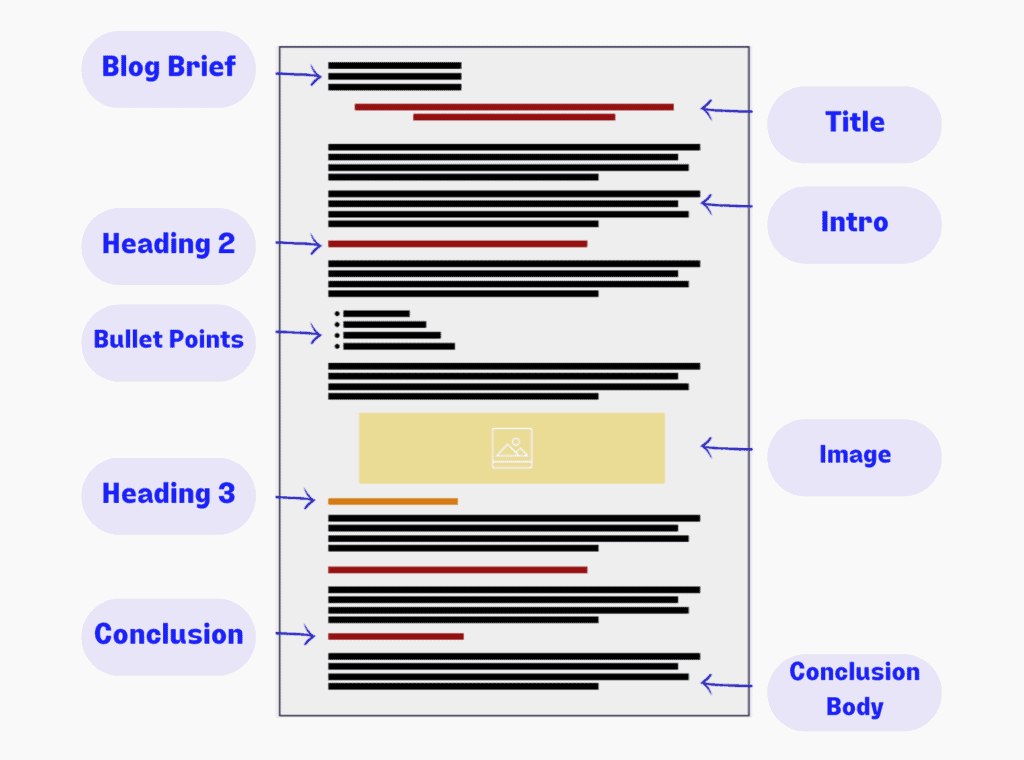
Why is building this foundation important?
It helps you make sure your content creators address all the vital topics. Plus, it helps streamline the writing process and reduces back-and-forth during revisions with the editor.
But how do you create a good outline?
Start by analyzing the top 10 content pieces on search engine results. From there, you can identify recurring topics, using their talking points as a guide on what to include in your outline.
Additionally, look at the “People Also Ask” section. It offers valuable information or questions your target audience is asking.
Don’t just copy and paste what you see. Incorporate your brand’s processes or systems when appropriate, a unique take on a specific workflow, or a fresh angle in a point you’re making. This way you’re giving your audience tested and proven insights.
This thorough research and originality blend elevates your content marketing, helping you stand out while delivering top-tier insights.
7. Is my content readable, understandable, actionable, and shareable?
This tactic helps you evaluate how effective your content is. How?
- Actionable insights empower them to take steps.
- Shareable elements amplify your content across marketing channels.
- Understandable content means they can easily grasp your message.
- Readable content means your content is clear, easy to understand, and scannable.
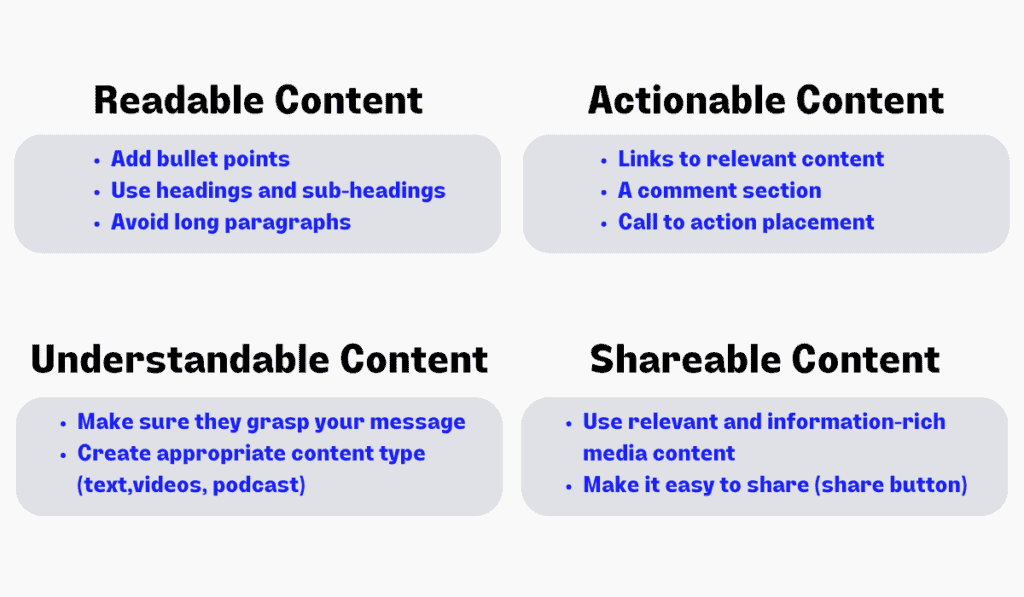
When you create content that checks all these boxes, you’re not just filling space; you’re crafting a tool for a successful business, making sure your audience stays informed, engaged, and connected to your brand.
How do you achieve this?
7.1. Media Content
While images add aesthetic appeal, infographics, and videos provide information in an easily digestible format. They simplify complex topics, making them more understandable and engaging. Plus, they’re more shareable, boosting content promotion across marketing channels.
7.2. Data-Driven Insights
Back your claims with data. Search engines and readers alike value content grounded in research and facts. It not only enhances credibility but also makes sure your content stands out as authoritative.
7.3. Value-Driven Content
Always ask, “What’s in it for the reader?” Your content should solve a problem, answer a question, or provide insights.
7.4 Structure & Elements
Start with a compelling headline, followed by an intriguing introduction. Keep the search intent in mind and reassure your readers they’ve landed on the article that will answer their queries. Use subheadings, bullet points, and short paragraphs to break up your text, making it skimmable and reader-friendly.
This holistic approach guarantees your content resonates, educates, and drives action, making it a powerful tool in your digital marketing arsenal.
8. How do I make my content search engine optimized?
This means diving into enhancing your content for better visibility on search engines.
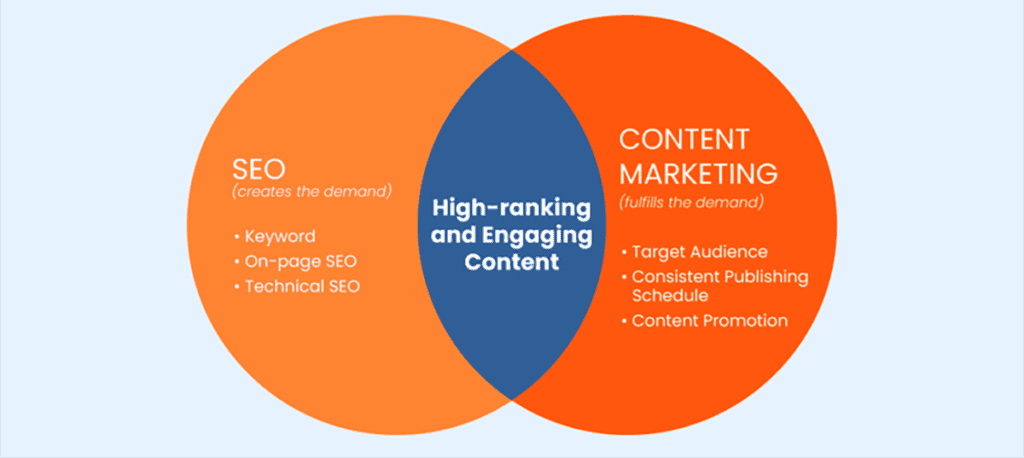
Why do you need to do search engine optimization?
Because SEO isn’t just a buzzword; it’s a cornerstone of an effective content marketing strategy.
How do you make SEO-friendly content?
- Optimizing Elements: Use target search terms in meta titles, descriptions, and headers. Yoast SEO, Frase, or SurferSEO can guide your SEO efforts, offering suggestions to improve readability and search term optimization.
- Deep Internal Linking Structure: Link to your existing content, guiding readers to other relevant articles or pages on your site. This not only keeps them engaged longer but also signals to search engines that your site has depth and authority.
- Link To Reputable External Links: While your content strategy should highlight your expertise, linking to reputable external sources, like websites with a domain authority score above 50, boosts credibility. It shows you’ve done your homework and are part of the broader conversation in your industry.
Overall, when you combine SEO with meeting your user needs, your content doesn’t just attract clicks but resonates, educates, and converts.
9. Is my draft publish-ready?
This prompts you to scrutinize your content meticulously before it goes live. A successful content marketing campaign means publishing content that’s polished and refined.
Why?
Polished, well-optimized content enhances your brand’s credibility and gets your message across as intended.
How do you make sure your draft can now be published?
Your content should be typo-free, with each point articulated clearly. Remember, you’re creating content for humans, not just algorithms. It should resonate with your target audience, answering their questions and addressing their needs.
Plus, make sure your content is in active voice. Here are some examples:
- Active Voice: The chef cooked a delicious meal.
- Passive Voice: A delicious meal was cooked by the chef.
You also need to be straightforward yet engaging. Here’s an example:
- Boost your rankings with our latest SEO guide!
- If you’re looking to really make a difference in your online presence, you might want to consider taking a look at our latest SEO guide to help boost your rankings.
To make this process seamless, use tools like Grammarly. Other than checking spelling, it helps you check clarity, conciseness, and correct grammar, refining your content’s voice.
If you’re using Google Docs, all you have to do is download the Grammarly extension from the Chrome Store. This lets you proofread your piece in real-time.
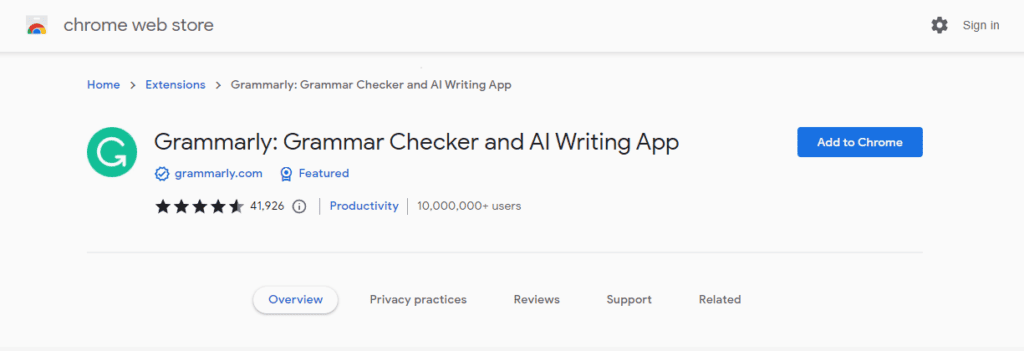
Additionally, you can use SurferSEO’s Content Editor to make your piece SEO-friendly. It checks for relevant search terms to incorporate and suggests adjustments in content structure, making sure your piece is valuable and discoverable.
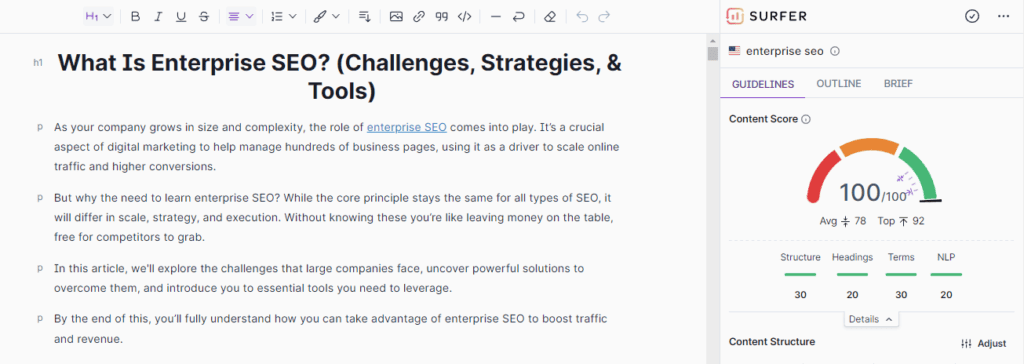
However, the most critical factor in the content marketing cycle is still the human touch. While those tools can catch errors, human editors are still irreplaceable. They can make sure your content aligns with the brand voice, message, and objectives, and resonates well with your audience.
The process involves multiple reads, ideally by a designated proofreader, to get a diverse perspective and catch any nuances or inconsistencies.
10. Do I include FAQs?
Integrating FAQs isn’t just a tick on your content marketing checklist, it’s a way to directly address your audience’s common queries and concerns.
Why is this crucial in content marketing?
It enhances your readers’ user experience. They don’t need to go to another website or post, they can have the most common queries answered in your blog. Plus, they help to incorporate long-tail keywords, increasing the chances of boosting your content’s visibility.
How do you determine which FAQs to include?
It’s Google to the rescue. Its “People Also Ask” feature showcases related questions that users frequently search for. It can help you get ideas about a topic’s broader context and the specific nuances your audience is curious about.
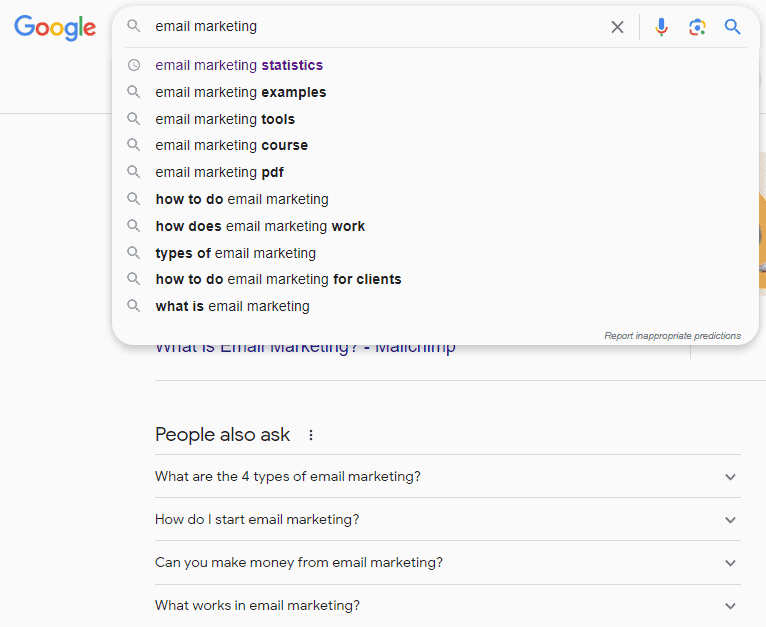
Moreover, Google’s Autocomplete function suggests common queries as you type in the search bar. These suggestions are based on popular searches, giving you a direct peek into what your audience wants to know.
After Content Creation
11. Do I measure the right KPIs to check if I met my goals?
After all the important tasks of content creation and content promotion, don’t forget to circle back. You have to track your blog with KPIs to gauge your content marketing efforts’ success and see if it achieves its intended purpose.
What KPIs should you track and how do you track them?
11.1. Page views
This measures content popularity. You can use Ahrefs’ “Website Traffic Checker” to monitor your organic or even paid traffic. Once you sign in, just go to Site Explorer, and you’ll see this dashboard.
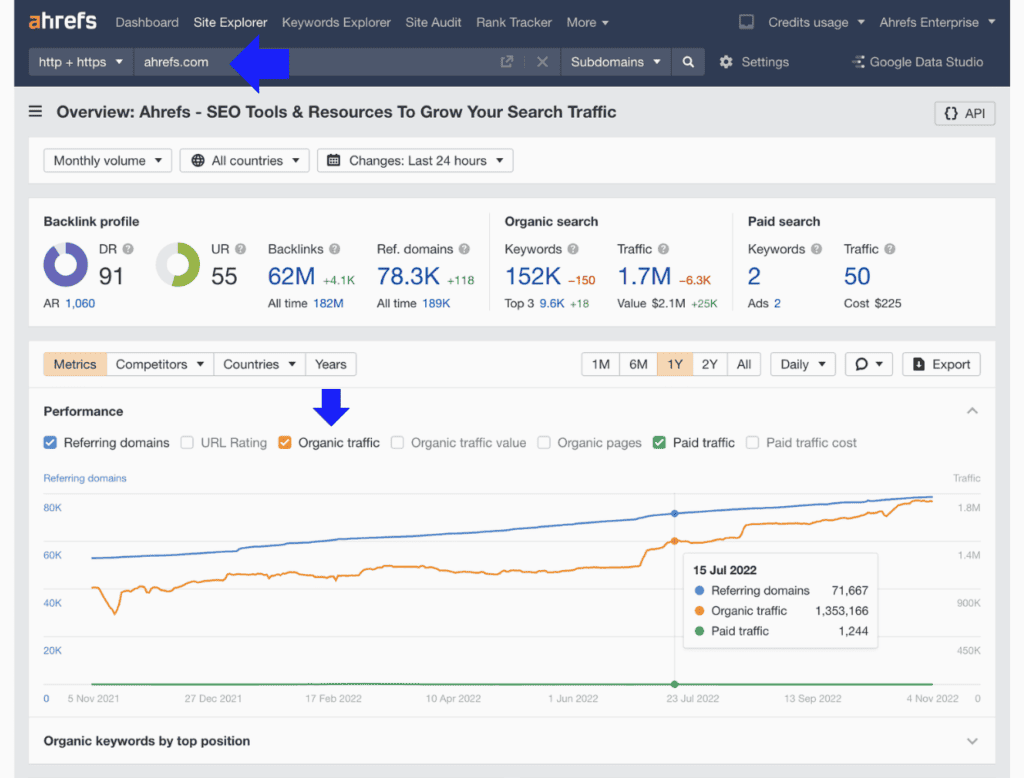
11.2. Number of Unique Visits
This indicates the span of your content’s reach. Use Google Analytics 4 for this.
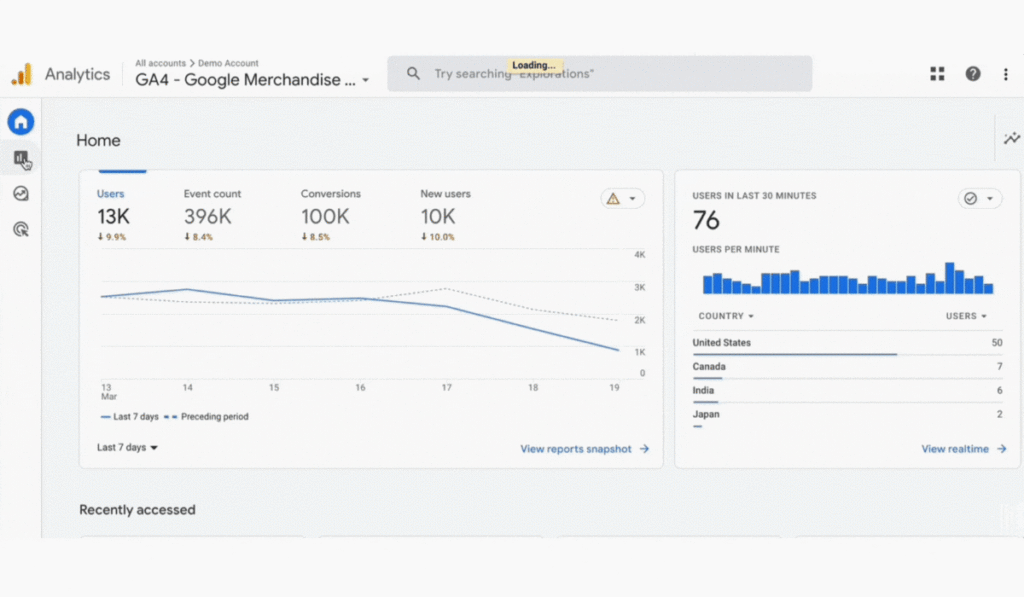
11.3. Number of Leads/Sales
This is to gauge ROI and how effective your content is. Use HubSpot’s free “Lead Management & Tracking Software” and analyze lead metrics and take the appropriate actions.
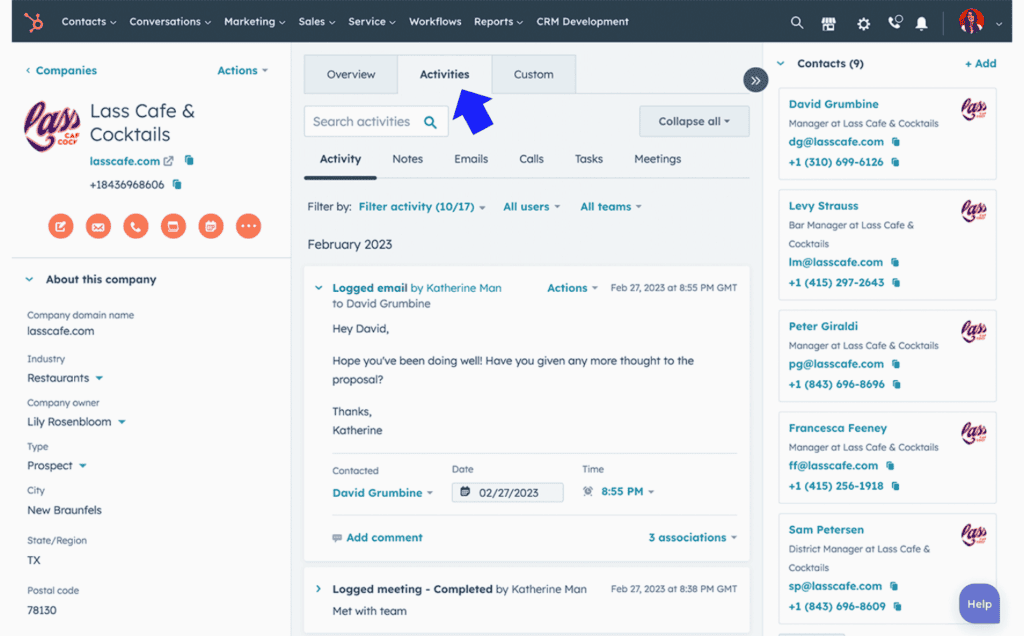
11.4. Google Keyword Ranking
This helps you understand your content’s SEO performance and see if you’re moving up the rankings. Use Semrush’s “Position Tracking” to regularly get automatic updates on how your chosen search terms are doing in Google.
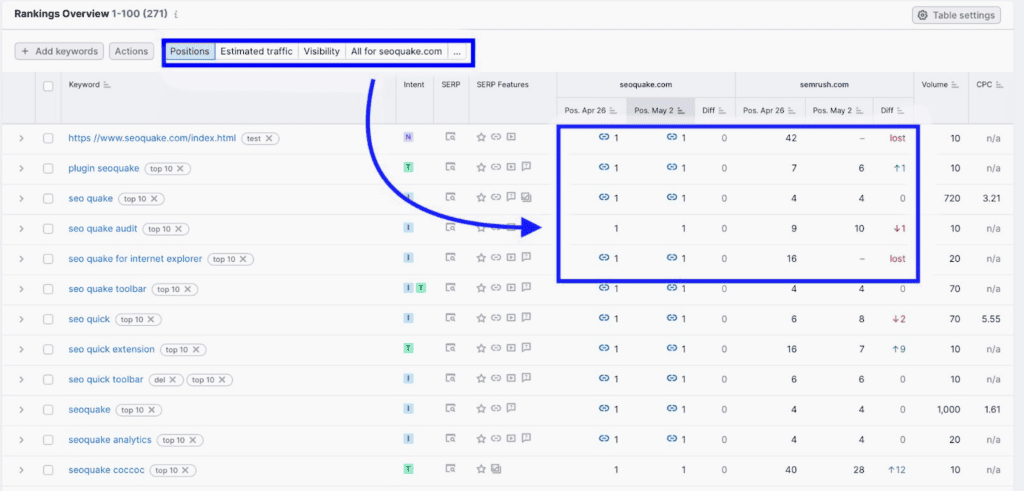
To make sure your content is on the right track, you need to revisit it after 2 weeks, 3 months, and 6 months to assess its performance. This not only helps in understanding what’s working but also guides future strategies.
Content Marketing Strategy Checklist Template
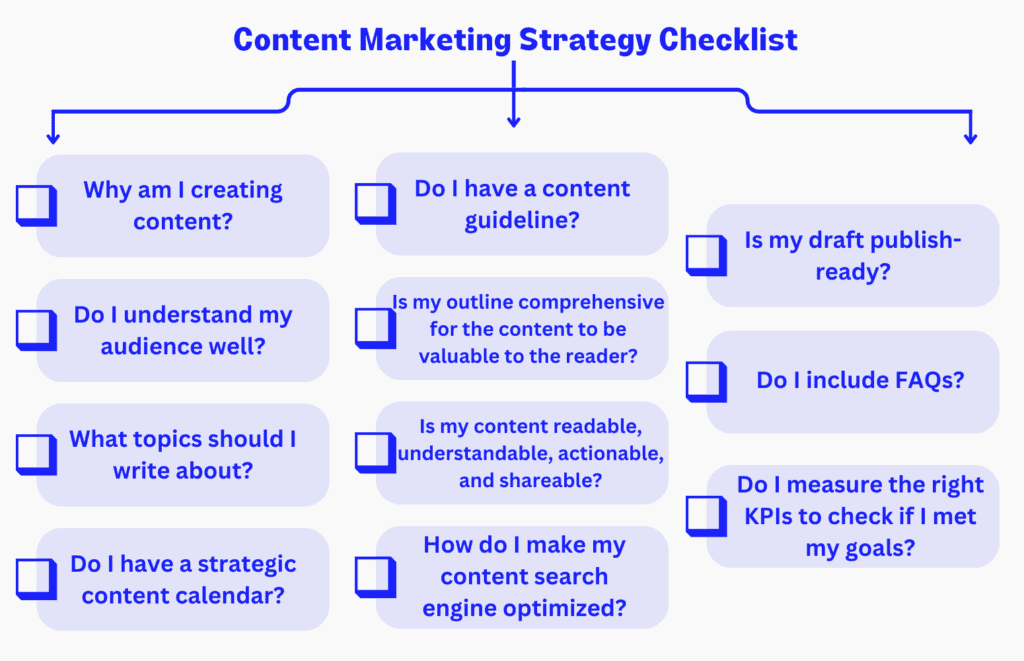
Are You Ready To Start Writing?
Writing content without a plan is a failure waiting to happen. But that can change when you leverage this content marketing strategy checklist. With this in your toolbox, you can make sure every content you create hits the bullseye for your users and search engines.
However, the digital marketing world is fickle, and what works today may not work a year from now. That’s why, as you apply the strategies and techniques provided here, keep up with SEO, content marketing, and industry trends.
But continuously evaluating and refining your content marketing strategy takes a lot of work.
How do you make it easier for your company?
Novum can help you stay ahead of the curve with our proven SEO-driven content marketing strategy. Our clients had significant growth in organic visits, traffic value, and leads, and we can help you experience the same.
Get started, and jump into a free roadmap call today!

